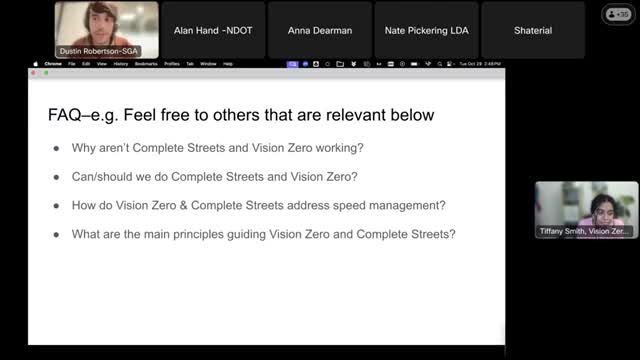Road design revolution aims to enhance safety and awareness
October 31, 2024 | Nashville Department of Transportation (NDOT) Meetings, Nashville, Davidson County, Tennessee
This article was created by AI summarizing key points discussed. AI makes mistakes, so for full details and context, please refer to the video of the full meeting. Please report any errors so we can fix them. Report an error »

During a recent government meeting, officials discussed the importance of road design in promoting safety and reducing vehicle speeds, emphasizing the need for a paradigm shift in how streets are constructed and utilized. The conversation highlighted the concept of \"natural cues\" in road design, which can influence driver behavior more effectively than speed limit signs alone.
One speaker illustrated this point by comparing two roads in the same area. He noted that while one road appeared to allow for higher speeds, the design elements of another road—such as its narrowness and potential pedestrian crossings—naturally encouraged slower driving. This observation underscored the idea that effective street design can guide drivers to adopt safer speeds without relying solely on regulatory signage.
The meeting also touched on the broader initiatives of Vision Zero and Complete Streets, which aim to prioritize safety over speed and promote equitable access to safe transportation. Officials stressed that these initiatives represent a comprehensive approach to road safety, focusing on data-driven design improvements rather than isolated projects.
As the discussion concluded, participants were encouraged to share their thoughts and questions, indicating a collaborative effort to refine these safety strategies. The meeting underscored a commitment to rethinking urban infrastructure to enhance safety for all road users.
One speaker illustrated this point by comparing two roads in the same area. He noted that while one road appeared to allow for higher speeds, the design elements of another road—such as its narrowness and potential pedestrian crossings—naturally encouraged slower driving. This observation underscored the idea that effective street design can guide drivers to adopt safer speeds without relying solely on regulatory signage.
The meeting also touched on the broader initiatives of Vision Zero and Complete Streets, which aim to prioritize safety over speed and promote equitable access to safe transportation. Officials stressed that these initiatives represent a comprehensive approach to road safety, focusing on data-driven design improvements rather than isolated projects.
As the discussion concluded, participants were encouraged to share their thoughts and questions, indicating a collaborative effort to refine these safety strategies. The meeting underscored a commitment to rethinking urban infrastructure to enhance safety for all road users.
View full meeting
This article is based on a recent meeting—watch the full video and explore the complete transcript for deeper insights into the discussion.
View full meeting
